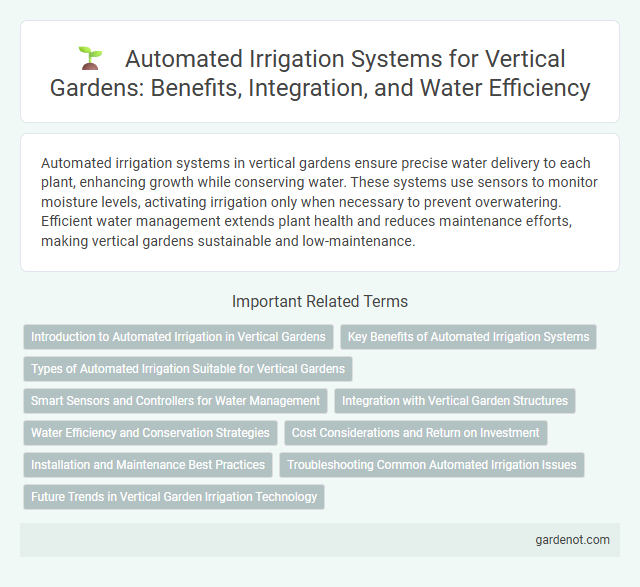Automated irrigation systems in vertical gardens ensure precise water delivery to each plant, enhancing growth while conserving water. These systems use sensors to monitor moisture levels, activating irrigation only when necessary to prevent overwatering. Efficient water management extends plant health and reduces maintenance efforts, making vertical gardens sustainable and low-maintenance.
Introduction to Automated Irrigation in Vertical Gardens
Automated irrigation systems in vertical gardens use sensors and timers to deliver precise water amounts directly to plant roots, optimizing moisture levels and conserving water. These systems integrate smart technology to monitor soil humidity and plant health, ensuring efficient irrigation without overwatering or underwatering. By automating watering schedules, vertical garden maintenance is simplified, promoting healthier plant growth and sustainability.
Key Benefits of Automated Irrigation Systems
Automated irrigation systems in vertical gardens optimize water usage by delivering precise amounts of moisture directly to plant roots, reducing water waste and supporting sustainable gardening practices. These systems enhance plant health and growth through consistent watering schedules, minimizing the risk of under- or over-watering. Integration with smart sensors enables real-time monitoring and adjustment, promoting energy efficiency and reducing maintenance efforts for vertical garden setups.
Types of Automated Irrigation Suitable for Vertical Gardens
Automated irrigation systems for vertical gardens include drip irrigation, which delivers water directly to plant roots through a network of tubes and emitters, minimizing water waste and promoting healthy growth. Micro-sprinklers provide gentle, uniform misting suitable for delicate plants and small spaces in vertical structures, ensuring even moisture distribution. Capillary mats can also be used for self-watering vertical gardens, absorbing water and slowly releasing it to plants, ideal for maintaining consistent humidity in compact arrangements.
Smart Sensors and Controllers for Water Management
Smart sensors and controllers in automated irrigation systems dramatically enhance water management efficiency in vertical gardens by detecting real-time soil moisture levels and environmental conditions. These advanced technologies enable precise water delivery tailored to each plant's needs, reducing water waste and promoting healthier plant growth. Integration with IoT platforms allows remote monitoring and adjustments, optimizing water use and supporting sustainable vertical gardening practices.
Integration with Vertical Garden Structures
Automated irrigation systems designed for vertical garden structures optimize water distribution through precise drip emitters and moisture sensors embedded within the plant layers. Integration with vertical garden frameworks ensures uniform hydration, reduces water waste, and supports plant health by maintaining consistent moisture levels. Smart controllers adapt irrigation schedules based on environmental data, enhancing sustainability and efficiency in vertical gardening.
Water Efficiency and Conservation Strategies
Automated irrigation systems in vertical gardens optimize water efficiency by utilizing sensors and timers that deliver precise amounts of water directly to plant roots, reducing runoff and evaporation. Advanced drip irrigation technologies and moisture sensors adjust watering schedules based on real-time soil moisture data, ensuring minimal water waste. Implementing rainwater harvesting and greywater recycling within automated systems further enhances conservation efforts, promoting sustainable water management practices.
Cost Considerations and Return on Investment
Automated irrigation systems for vertical gardens reduce water waste by up to 30%, significantly lowering utility bills over time. Initial installation costs range from $500 to $2,000 depending on system complexity and garden size, but savings on labor and irrigation efficiency generate an average ROI within 2-3 years. Investing in smart irrigation technology enhances plant health and growth, increasing property value by as much as 5%.
Installation and Maintenance Best Practices
Automated irrigation systems for vertical gardens require precise installation of drip emitters and moisture sensors to ensure consistent water distribution and avoid overwatering. Regular maintenance includes cleaning filters, checking sensor calibration, and inspecting tubing for leaks to optimize water efficiency and plant health. Scheduling seasonal system audits helps adapt irrigation levels to changing environmental conditions and plant growth stages.
Troubleshooting Common Automated Irrigation Issues
Automated irrigation systems in vertical gardens often face issues such as clogged nozzles, uneven water distribution, and sensor malfunctions. Regular maintenance includes checking for debris buildup, ensuring correct water pressure, and recalibrating moisture sensors to prevent overwatering or underwatering. Timely diagnosis and adjustment of these components optimize water efficiency and promote healthy plant growth in vertical gardens.
Future Trends in Vertical Garden Irrigation Technology
Automated vertical garden irrigation systems are increasingly integrating IoT sensors and AI-driven analytics to optimize water usage and plant health. Future trends highlight smart drip irrigation techniques combined with real-time environmental data for precise moisture control. These advancements aim to enhance sustainability and reduce maintenance efforts in urban vertical gardening.
Automated irrigation garden Infographic

 gardenot.com
gardenot.com